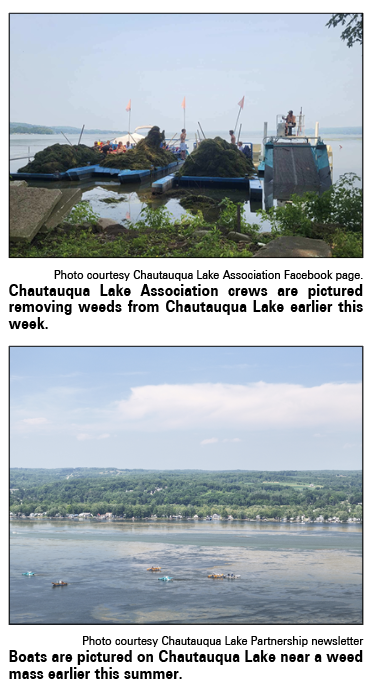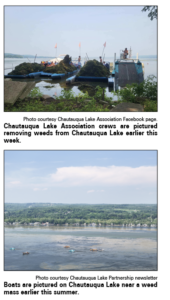CLPOA Lashes Back At DEC

DEC officials say Chautauqua Lake hasn’t been affected by Freshwater Wetlands Act regulations that took effect in January.
Chautauqua Lake Property Owners Association members – along with the Builders Exchange of the Southern Tier, town of Ellery and Bemus Point Business Association – beg to differ.
Larry Anderson, Ellery town supervisor, said herbicide applications this year were much more difficult when having to fill out an Article 24 permit as opposed to the Article 15 permits used in previous years. DEC Region 9 officials issued a positive jurisdictional determination without any request from the town, something that hadn’t happened before and which Anderson said isn’t provided for in-lake in the new regulations or the DEC’s operating procedures. Anderson also took issue with part of the lake in Ellery being declared wetlands despite not having enough vegetation to use herbicides in.
“Ultimately, we modified our treatment program to treat less areas in the time left to us once the permits were issued. Were it not for the flexibility of our weed management group CLP, the window would have been missed. There were some areas included in the (jurisdictional determination) that the NYSDEC Region 9 determined did not even have sufficient vegetation to warrant any treatment but had been designated wetlands, nonetheless.”
As The Post-Journal reported earlier this year, Ellery and other lakefront towns and villages have begun using waiver forms letting people know the towns and villages take no responsibility for a project’s compliance with the Freshwater Wetlands Act. Town officials are also spending more time explaining the jurisdictional determination process both during monthly meetings and when people ask for building permits.
Jim Wehfritz, CLPOA director, wrote in his reply to the DEC’s response that his property has received a positive jurisdictional determination for submerged weeds just off his dock. He said that means he has to seek an Article 24 permit or letter of permission from the DEC to clear weeds from his shorefront, modify his boathouse or dock or conduct shoreline activities.
“Most critically, my lands were unregulated under Article 24 before January 1, 2025,” Wehfritz said. “I could engage in all the normal incidents of home ownership without the need for anything other than local permits and approvals. Now my lands are in part inside the boundaries of an undefined “Regulated Adjacent Area,” and subject to the full panoply of restrictions, conditions, bans and other requirements and obligations under Article 24, the violation of which subjects me to potential civil and criminal penalties. The present harm to me and those similarly situated is thus undeniable.”
The in-lake jurisdictional determination that prompted a higher level of review for in-lake maintenance and which Wehfritz and property owners say makes it more difficult to perform property maintenance on private property near the lake did not follow the process spelled out in the DEC’s regulations, according to Wehrfritz. The jurisdictional determination for the area near his property was not accompanied by any remote evaluation as provided for in
the new regulations or wetlands delineation, he said, nor has any delineation since been published or public notice given. Under the new regulations, the regulated freshwater wetland includes the 100 foot regulated adjacent area – but the only way to quantify that area is using precise data garnered during an on-site field visit.
“To my knowledge, no such on-site visit, or delineation exists for the in-lake wetlands area in front of my land,” Wehrfritz said in his affidavit. “Given the proximity of this now jurisdictional (now under ECL Article 24 and ECL
Article 15) submerged wetland, my property (and likely that of many of my neighbors and other lakeside landowners) is included in a Regulated Adjacent Area, and thus subject to the full panoply of wetlands restrictions under Article 24. Where exactly that Regulated Adjacent Area begins and ends on my property is at this time anyone’s guess, as the Water Affidavit admits.”
At the same time, Keri Belovarac, registered architect from Bemus Bay Architecture, said she has no way of advising clients and potential clients as to the location of regulated freshwater wetlands or regulated adjacent areas, much less the impact of their identification on design and construction. When NYSDEC determines that an area from the shoreline out to 6-feet deep is a Regulated Freshwater Wetland, it also must necessarily identify a 100′ (minimum) Regulated Adjacent Area in connection therewith. That 100′ Regulated Adjacent Area will land somewhere in the upland area, even into already developed areas, and subject those areas to stringent regulation. The DEC has not provided, nor do they intend to provide, current definitive maps for professional use. This leaves me liable for advising a client to either move forward or not move forward with a project.
Belovarac’s affidavit described a project she began working on in late February, when the architect began a parcel determination request online. There was no reply within 90 days, so a certified letter was sent to the DEC in mid-May. An email was received nine days later saying the project had a positive parcel jurisdictional determination. Belovarac then sent an email to schedule a delineation, receiving an email back at the end of June saying the DEC has received so many emails since the Freshwater Wetlands Act changes took effect in January that requests are being processed in the order they are received, often taking several weeks or more to process. A form was received related to the request on July 23, with nothing done since. The project is now waiting for the DEC to schedule the delineation, when an ecologist will go to the site. Then documentation has to be sent from the DEC back to the architectural firm and the architect has to submit forms for a project determination. The DEC then has another 90 days to respond. If a positive project determination is received from the DEC then the project has to begin a wetland permit application.
“As the court can discern, the new process is confusing, and not at all efficient or effective. Critical projects are being delayed, first by the uncertainty, and second by the bureaucratic delays now built into the system,” Belovarac said. “Potential clients have decided not to move forward due to this. All of this is causing real, present financial and other economic harm to small businesses like mine, the contractors and subcontractors we work with and the local governments to whom we look for guidance.”



